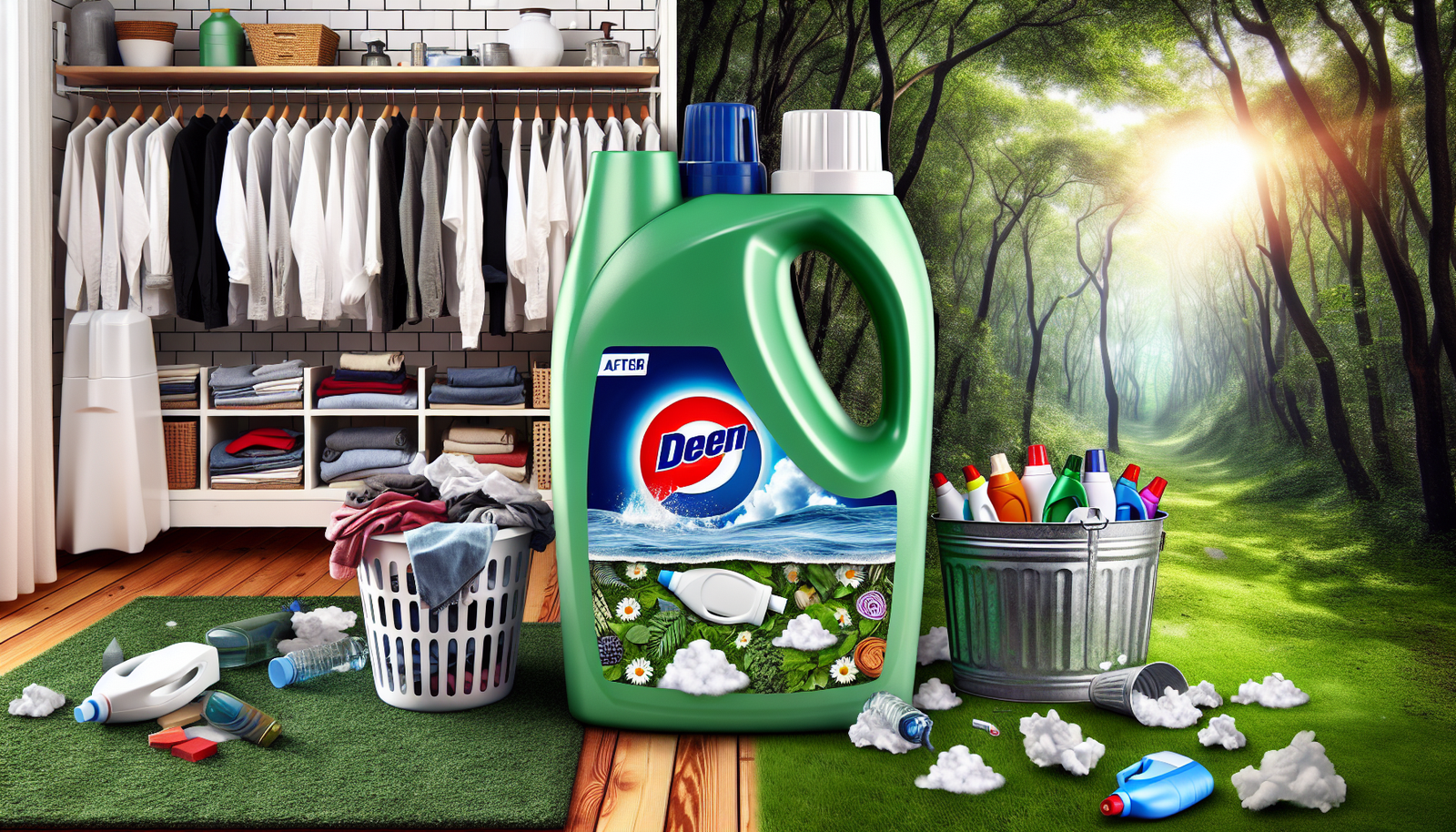Imagine a world where Tide detergent, the trusted companion in everyone’s laundry routine, suddenly becomes a forbidden fruit. Yes, you heard it right – a tide detergent ban! It may seem unfathomable, but a recent decision by authorities has rocked the laundry world, leaving people wondering what alternative options they have in the face of this unexpected restriction. In this article, we will explore the reasons behind the tide detergent ban and discover how you can keep your clothes clean and fresh without this beloved household name. Get ready to rethink your laundry game!
The History of Tide Detergent
The Introduction of Tide Detergent
Tide detergent is a household name that has been around for decades, known for its exceptional cleaning power and strong brand presence. The story of Tide begins in the early 1940s when Procter & Gamble, a renowned consumer goods company, set out to create a superior laundry detergent for American households. The goal was to develop a product that could remove tough stains effectively while being gentle on fabrics.
Introduced in 1946, Tide quickly gained popularity among consumers due to its innovative formula and efficient cleaning capabilities. It was the first detergent that combined synthetic surfactants, enzymes, and builders, resulting in a highly effective cleaning solution that revolutionized laundry practices. From its inception, Tide was positioned as a premium product, offering a superior cleaning experience compared to other detergents available at the time.
Tide as a Leading Brand in the Market
Over the years, Tide cemented its position as a leading brand in the detergent market. Its consistent quality and effective stain removal made it a trusted choice for households across the globe. Tide’s success can be attributed to its commitment to innovation and continuous improvement. The brand introduced new variants to cater to different laundry needs, such as Tide Free & Gentle for sensitive skin and Tide Plus Downy for added fabric softening.
Tide also leveraged effective marketing strategies to build brand equity. Through compelling advertising campaigns, the brand connected with consumers emotionally, emphasizing the importance of clean, fresh-smelling clothes in everyday life. Tide’s iconic orange packaging became synonymous with cleanliness, and the brand became a household staple in many countries.
The Growing Environmental Concerns
The Impact of Detergent on the Environment
While Tide gained popularity as a highly effective detergent, concerns started to arise regarding its impact on the environment. Traditional laundry detergents, including Tide, contain chemicals that can be harmful to aquatic life when discharged into water bodies. These chemicals, known as phosphates, can cause imbalances in ecosystems, leading to the growth of harmful algal blooms and degradation of water quality.
Additionally, the production and disposal of detergent contribute to pollution and waste. The manufacturing process releases greenhouse gases and consumes large amounts of energy and water. Furthermore, the plastic packaging commonly used for detergents can end up in landfills and oceans, contributing to the global plastic pollution crisis.
The Rise of Eco-Friendly Alternatives
In response to the growing environmental concerns associated with traditional detergents, the market witnessed a rise in eco-friendly alternatives. These alternatives aim to provide effective cleaning while minimizing the negative impact on the environment. Eco-friendly detergents are typically made from natural and biodegradable ingredients, free from phosphates and other harmful chemicals.
Consumers increasingly gravitated towards eco-friendly options, seeking to reduce their ecological footprint and protect the planet. Many of these alternative detergents are formulated to be hypoallergenic and gentle on both fabrics and skin. Some brands even offer refillable packaging or packaging made from recyclable materials, further addressing the issue of packaging waste.

The Controversial Ingredients in Tide Detergent
Chemicals Used in Tide Detergent
Tide detergent, like many conventional detergents, contains a range of chemicals that contribute to its cleaning power. One controversial ingredient found in Tide is sodium laureth sulfate (SLES), a surfactant that helps to remove stains and dirt from fabrics. SLES has been associated with skin irritation in some individuals and can also have adverse effects on the environment.
Another contentious ingredient is 1,4-dioxane, a byproduct of the ethoxylation process used to manufacture surfactants like SLES. 1,4-dioxane is classified as a probable human carcinogen by the United States Environmental Protection Agency (EPA). Though present in very small amounts in the final detergent, some consumers and environmental activists express concerns about potential health risks associated with its presence.
Potential Health Hazards
The presence of certain ingredients in Tide detergent has raised concerns about potential health hazards. While the concentrations of these substances in the final product are within regulatory limits, some individuals may be more sensitive to their effects. The ingredients mentioned earlier, such as SLES and 1,4-dioxane, have been associated with skin irritation and allergies in certain cases.
Furthermore, the use of Tide detergent in poorly ventilated spaces or with incorrect dosage can lead to an increase in indoor air pollution. Volatile organic compounds (VOCs), released during the drying process, can contribute to poor indoor air quality, possibly causing respiratory issues and exacerbating existing conditions in some individuals.
Calls for a Tide Detergent Ban
Environmental Activists’ Stance
Driven by the growing concern for the environment and the potential health risks associated with Tide detergent, environmental activists have been calling for a ban on the sale and use of the product. These activists argue that the harmful impact of Tide detergent’s ingredients and its contribution to pollution outweigh its cleaning efficiency.
Various organizations have been advocating for stricter regulations on detergent manufacturing, emphasizing the need for increased transparency about the ingredients used. Some environmental groups have conducted studies to raise awareness about the potential risks associated with Tide and similar detergents, urging consumers to opt for safer alternatives.
Consumer Concerns and Boycotts
As awareness about the potentially harmful aspects of Tide detergent spread, a significant number of consumers expressed their concerns and started boycotting the brand. Social media platforms became instrumental in organizing and voicing their opinions, as consumers shared their experiences and concerns with each other. Many users advocated for stricter regulations and disclosed their shift to eco-friendly alternatives.
The consumer boycotts and increasing demand for greener alternatives caught the attention of both Procter & Gamble and regulatory bodies, leading to further examination of the ingredients in Tide detergent and their potential impact on human health and the environment.

Regulatory Actions and Public Pressure
Government Regulations on Detergent Ingredients
In response to public concerns and pressure from environmental activists, governments around the world began reviewing the regulations governing detergent manufacturing. The aim was to evaluate the safety and environmental impact of the chemicals used in detergents, including Tide.
Government regulatory bodies worked closely with scientific experts to assess the potential risks associated with certain detergent ingredients. This led to the introduction of stricter guidelines and limitations on the use of specific compounds in detergent formulations. Some countries even banned or restricted the sale and use of detergents containing certain harmful chemicals.
Public Pressure to Ban Harmful Chemicals
Alongside government actions, public pressure played a crucial role in prompting the reassessment of Tide detergent and its ingredients. Consumers, armed with knowledge about the potential risks, demanded more transparency and safer products. They actively participated in online petitions, wrote to their elected officials, and engaged in discussions with environmental organizations to voice their concerns.
The collective pressure from environmentally conscious consumers, combined with the efforts of environmental activists, prompted Procter & Gamble to address the concerns and reevaluate its formulations.
Tide’s Response and Claims
Tide’s Defense Against the Ban
In response to the calls for a ban, Procter & Gamble defended the safety and quality of Tide detergent. The company highlighted the extensive research and testing conducted to ensure that their products meet or exceed regulatory standards for safety. They emphasized that the concentrations of potentially harmful ingredients in Tide are within the acceptable limits and do not pose significant health risks when used as directed.
Procter & Gamble also stated that the environmental impact of Tide detergent extends beyond just the formulation. The company has made efforts to reduce the carbon footprint of its manufacturing processes and has implemented green initiatives, such as using renewable energy sources and adopting more sustainable packaging practices.
Promotion of Safer Formulations
In order to address consumer concerns and mitigate potential risks, Procter & Gamble introduced new formulations of Tide detergent with improved safety profiles. These new options aim to minimize skin sensitivities and reduce the presence of certain controversial ingredients, such as SLES and 1,4-dioxane. The company asserted that these changes have been made as part of their commitment to continuous improvement and responding to evolving consumer needs.
Procter & Gamble actively promoted the benefits and safety of these updated formulations, highlighting their effectiveness in removing stains while being gentle on fabrics and skin. They encouraged consumers to choose the variant that best suits their individual preferences and needs.

Alternatives to Tide Detergent
Eco-Friendly Detergent Options
As the demand for eco-friendly products continues to rise, numerous alternatives to Tide detergent have appeared in the market. These eco-friendly detergents are formulated with plant-based ingredients and utilize biodegradable surfactants, reducing their impact on the environment.
Many of these eco-friendly options claim to be just as effective as conventional detergents like Tide, promising to remove tough stains and odors without compromising on performance. These alternatives often come in recyclable or biodegradable packaging, aligning with the principles of sustainability and waste reduction.
DIY Alternatives
In addition to commercially available eco-friendly detergents, some individuals opt for DIY alternatives as a more affordable and customizable option. Homemade laundry detergents can be made using readily available ingredients, such as baking soda, vinegar, and essential oils. These recipes often involve simple mixing and can be tailored to personal preferences by varying ingredient ratios and scent combinations.
DIY alternatives allow individuals to have full control over the ingredients used, minimizing the chances of exposure to potentially harmful substances. However, it is important to note that not all homemade recipes are equally effective, and individuals may need to experiment to find the best option for their specific laundry needs.
The Economic Impact of a Tide Detergent Ban
Effect on Procter & Gamble and Other Detergent Manufacturers
A potential ban on Tide detergent would have significant economic implications, not only for Procter & Gamble but also for other detergent manufacturers. Tide is one of the leading brands in the detergent market, and a ban could result in a substantial loss of revenue for the company.
In addition, the ban would create opportunities for competing brands and eco-friendly alternatives to fill the market gap left by Tide. Detergent manufacturers that offer eco-friendly options could experience a surge in demand, potentially reshaping the competitive landscape within the industry.
Price Changes and Market Shifts
The introduction of a ban on Tide detergent could also have an impact on pricing and market dynamics. If the ban leads to increased production costs for eco-friendly alternatives, consumers may see a rise in detergent prices. However, increased demand for these alternatives could also promote economies of scale, ultimately leading to more affordable options.
Furthermore, a ban on Tide detergent may trigger a shift in consumer preferences, encouraging households to adopt more sustainable laundry practices. This could include reducing overall laundry loads, using cold water washes, and exploring alternative cleaning methods such as eco-friendly laundry balls or soap nuts.

The Future of Tide Detergent
The Potential Ban and Its Implications
The possibility of a ban on Tide detergent and similar products signals a growing concern among consumers and regulatory bodies regarding the safety and environmental impact of conventional detergents. If a ban were to be implemented, it would likely prompt further innovation in the detergent industry, driving the development of safer and more sustainable alternatives.
Moreover, a Tide ban could serve as a catalyst for the adoption of stricter regulations worldwide, leading to a shift towards greener and more responsible manufacturing practices. This could result in a more sustainable and environmentally conscious approach to overall product development and waste management.
The Need for Sustainable Laundry Practices
Regardless of the outcome, the discussions surrounding the potential ban on Tide detergent highlight the importance of sustainable laundry practices. Consumers play a crucial role in reducing the environmental impact of laundry detergents by making informed choices and adopting eco-friendly alternatives.
Practices such as using appropriate dosage, washing full loads, and favoring cold water washes can significantly reduce water and energy consumption. Additionally, recycling detergent packaging and supporting brands committed to sustainability can contribute to a more responsible approach to laundry care.
Conclusion
The history of Tide detergent showcases its remarkable journey from being an innovative cleaning solution to becoming a leading brand in the market. However, as environmental concerns and potential health risks associated with its ingredients came to light, calls for a Tide detergent ban gained momentum.
Environmental activists and concerned consumers have raised valid points about the impact of detergent on the environment and human health. This has led to regulatory actions, public pressure, and a demand for safer alternatives. Procter & Gamble, in response, has defended the safety and quality of its product while introducing new formulations to address consumer concerns.
The potential ban on Tide detergent carries economic implications for Procter & Gamble and other manufacturers, but it also opens doors for eco-friendly alternatives to thrive. The future of Tide detergent remains uncertain, but the discussions surrounding it emphasize the need for sustainable laundry practices and a shift towards greener solutions for the benefit of our planet and future generations.
